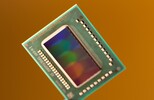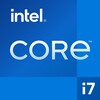Intel Core i7-3520M vs Intel Core i7-1180G7 vs Intel Core i3-1110G4
Intel Core i7-3520M
► remove from comparison
The Intel Core i7-3520M is the fastest dual-core processor for laptops based on the Ivy Bridge architecture at the time of introduction in Q2 2012. Due to Hyperthreading, the two cores can handle up to four threads in parallel leading to better utilization of the CPU. Each core offers a base speed of 2.9 GHz but can dynamically increase clock rates with Turbo Boost up to 3.4 GHz (for 2 active cores) and 3.6 GHz (for 1 active core). As its Sandy-Bridge-based predecessor Core i7-2640M, it offers a 4 MB L3-Cache.
Ivy Bridge is an enhanced die shrink of the Sandy Bridge architecture with improvements on both GPU and CPU performance. The CPUs are produced in 22nm (versus 32nm Sandy Bridge CPUs) and are the first to introduce 3D transistors for increased energy efficiency when compared to similarly clocked Sandy Bridge processors. Other new features are integrated PCI Express 3.0 and DDR3(L)-1600 support.
The performance of the Core i7-3520M is slightly above a similarly clocked Sandy Bridge processor due to the architectural improvements. As a result, overall performance is about 5 - 10 % above the old i7-2640M (see benchmarks below).
The integrated Intel HD Graphics 4000 offers 16 Execution Units (EUs) clocked at 650 MHz up to 1250 MHz with Turbo Boost, making it one of the fastest variants.
Just like most other Ivy Bridge dual-cores, the i7-3520M is rated at a TDP of 35 W. Therefore, even smaller laptops can use the Core i7.
Intel Core i7-1180G7
► remove from comparison
The Intel Core i7-1180G7 is a power-efficient quad-core SoC for laptops and Ultrabooks based on the Tiger Lake-U generation (UP4) that was introduced in early 2021. It integrates four Willow Cove processor cores (8 threads thanks to Hyper-Threading). The guaranteed base clock speed depends on the TDP setting and can range from 0.9 (7 W TDP) to 2.2 GHz (15 W TDP). The Turbo clock speed is specified at 4.6 GHz for one core, all cores can reach up to 3.7 GHz.
Another novelty is the integrated Xe graphics card with 96EUs based on the completely new Gen 12 architecture. It offers a significantly higher performance compared to the older Iris Plus G7 (Ice Lake). The GPU and CPU can together use the 12 MB of L3 cache.
Furthermore, Tiger Lake SoCs add PCIe 4 support (four lanes), AI hardware acceleration, and the partial integration of Thunderbolt 4 / USB 4 and Wi-Fi 6 in the chip. The i5-1140G7 also supports the management feature vPro.
The chip is produced on the improved 10nm process (called SuperFin) at Intel that should be comparable to the 7nm process at TSMC (e.g. Ryzen 4000 series).
The operating range of the UP4 series is specified at 7 to 15 Watt. Therefore, the processor is well suited for very thin and light laptops, convertibles or tablets.
Intel Core i3-1110G4
► remove from comparison
The Intel Core i3-1110G4 is a power-efficient dual-core SoC for laptops and Ultrabooks based on the Tiger Lake-U generation (UP4) that was launched in September 2020. It integrates two Willow Cove processor cores (4 threads thanks to HyperThreading). Each core can clock from 1.5 GHz (base speed at 7 Watt TDP setting) to 3.9 GHz (single- and dual-core boost). With 15 Watt TDP (cTDP-up) the base speed is 2.5 GHz.
Another novelty is the integrated Xe graphics card based on the completely new Gen 12 architecture. The i3 integrates the low end UHD Graphics G4 with 48 of the 96 EUs enabled and a clock speed of 400 - 1100 MHz. The GPU and CPU can together use the 6 MB of L3 cache.
Furthermore, Tiger Lake SoCs add PCIe 4 support (four lanes), AI hardware acceleration, and the partial integration of Thunderbolt 4 / USB 4 and Wi-Fi 6 in the chip.
Performance
The average 1110G4 in our database is in the same league as the Celeron N5105, as far as multi-thread benchmark scores are concerned. This is the kind of performance that entry-level chips deliver, as of late 2023.
Your mileage may vary depending on how competent the cooling solution of your system is and how high the CPU power limits are.
Power consumption
Intel Core i3-1110G4 has a default TDP (also known as the long-term Power Limit) of 7 W to 15 W, the expectation being that laptop manufacturers will go for a higher value in exchange for higher performance. This Core i3 is built with the 3rd generation 10 nm process marketed as SuperFin making for decent, as of mid-2022, energy efficiency.
| Model | Intel Core i7-3520M | Intel Core i7-1180G7 | Intel Core i3-1110G4 | ||||||||||||||||||||||||||||||||||||||||||||||||||||||||||||||||||||||||||||||||||||||||||||||||||||||||||||||||||||||||||||
| Codename | Ivy Bridge | Tiger Lake-UP4 | Tiger Lake-UP4 | ||||||||||||||||||||||||||||||||||||||||||||||||||||||||||||||||||||||||||||||||||||||||||||||||||||||||||||||||||||||||||||
| Series | Intel Core i7 | Intel Tiger Lake | Intel Tiger Lake | ||||||||||||||||||||||||||||||||||||||||||||||||||||||||||||||||||||||||||||||||||||||||||||||||||||||||||||||||||||||||||||
| Series: Tiger Lake Tiger Lake-UP4 |
|
|
| ||||||||||||||||||||||||||||||||||||||||||||||||||||||||||||||||||||||||||||||||||||||||||||||||||||||||||||||||||||||||||||
| Clock | 2900 - 3600 MHz | 2200 - 4600 MHz | 2500 - 3900 MHz | ||||||||||||||||||||||||||||||||||||||||||||||||||||||||||||||||||||||||||||||||||||||||||||||||||||||||||||||||||||||||||||
| L1 Cache | 128 KB | 320 KB | 160 KB | ||||||||||||||||||||||||||||||||||||||||||||||||||||||||||||||||||||||||||||||||||||||||||||||||||||||||||||||||||||||||||||
| L2 Cache | 512 KB | 5 MB | 2.5 MB | ||||||||||||||||||||||||||||||||||||||||||||||||||||||||||||||||||||||||||||||||||||||||||||||||||||||||||||||||||||||||||||
| L3 Cache | 4 MB | 12 MB | 6 MB | ||||||||||||||||||||||||||||||||||||||||||||||||||||||||||||||||||||||||||||||||||||||||||||||||||||||||||||||||||||||||||||
| Cores / Threads | 2 / 4 | 4 / 8 | 2 / 4 | ||||||||||||||||||||||||||||||||||||||||||||||||||||||||||||||||||||||||||||||||||||||||||||||||||||||||||||||||||||||||||||
| TDP | 35 Watt | 15 Watt | 15 Watt | ||||||||||||||||||||||||||||||||||||||||||||||||||||||||||||||||||||||||||||||||||||||||||||||||||||||||||||||||||||||||||||
| Technology | 22 nm | 10 nm | 10 nm | ||||||||||||||||||||||||||||||||||||||||||||||||||||||||||||||||||||||||||||||||||||||||||||||||||||||||||||||||||||||||||||
| max. Temp. | 105 °C | 100 °C | 100 °C | ||||||||||||||||||||||||||||||||||||||||||||||||||||||||||||||||||||||||||||||||||||||||||||||||||||||||||||||||||||||||||||
| Socket | BGA1023, PGA988 | BGA1598 | BGA1598 | ||||||||||||||||||||||||||||||||||||||||||||||||||||||||||||||||||||||||||||||||||||||||||||||||||||||||||||||||||||||||||||
| Features | HD Graphics 4000, DDR3-1600 Memory Controller, HyperThreading, AVX, Quick Sync, Virtualization | DL Boost, GNA, Wi-Fi 6 (Gig+), Thunderbolt 4, LPDDR4x-4266 | LPDDR4x-4266 RAM, PCIe 4, 2 GT/s bus, DL Boost, GNA, MMX, SSE, SSE2, SSE3, SSSE3, SSE4.1, SSE4.2, AVX, AVX2, AVX-512, BMI2, ABM, FMA, ADX, SMEP, SMAP, EIST, TM1, TM2, Hyper-Threading, Turbo, SST, AES-NI, RDRAND, RDSEED, SHA | ||||||||||||||||||||||||||||||||||||||||||||||||||||||||||||||||||||||||||||||||||||||||||||||||||||||||||||||||||||||||||||
| iGPU | Intel HD Graphics 4000 (650 - 1250 MHz) | Intel Iris Xe Graphics G7 96EUs (400 - 1100 MHz) | Intel UHD Graphics Xe G4 48EUs (400 - 1100 MHz) | ||||||||||||||||||||||||||||||||||||||||||||||||||||||||||||||||||||||||||||||||||||||||||||||||||||||||||||||||||||||||||||
| Architecture | x86 | x86 | x86 | ||||||||||||||||||||||||||||||||||||||||||||||||||||||||||||||||||||||||||||||||||||||||||||||||||||||||||||||||||||||||||||
| $346 U.S. | |||||||||||||||||||||||||||||||||||||||||||||||||||||||||||||||||||||||||||||||||||||||||||||||||||||||||||||||||||||||||||||||
| Announced | |||||||||||||||||||||||||||||||||||||||||||||||||||||||||||||||||||||||||||||||||||||||||||||||||||||||||||||||||||||||||||||||
| Manufacturer | ark.intel.com | ark.intel.com | ark.intel.com |
Benchmarks
Average Benchmarks Intel Core i7-3520M → 100% n=3
Average Benchmarks Intel Core i7-1180G7 → 163% n=3
Average Benchmarks Intel Core i3-1110G4 → 89% n=3
* Smaller numbers mean a higher performance
1 This benchmark is not used for the average calculation












